|
Report from
Europe
EU wood imports rise to highest level since financial
crises
The total value of EU imports of wood products was
euro17.20 billion in 2015, 12% more than in 2014. This
followed an increase of 10% to euro15.3 billion in 2014.
In 2015 EU import value was at the highest level since
2008 just before the global financial crises (Chart 1).
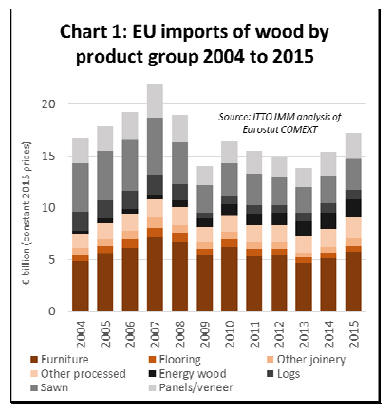
The surge in the euro value of imports in 2015 was partly
owing to the weakness of the euro which on average was
valued around 20% less against the dollar in 2015
compared to 2014. This meant that euro import prices for
most products from the Americas and Asia increased.
Import volumes also increased across most wood product
groups in 2015 but to a lesser extent than euro value.
The euro value of imports increased across all wood
product groups in both 2014 and 2015 (Chart 2). Imports
of wood furniture, which had been declining to 2013,
rebounded 10% in 2014 and 13% in 2015 to reach
euro5.78 billion.
Imports of sawn wood rebounded from a low in 2013,
rising 10% in 2014 and 12% in 2015 to reach euro3.04.
Similarly imports of panels (mainly plywood) increased
13% in 2014 and 11% in 2015 to reach euro2.44 billion.
The long term rise in imports of energy wood continued in
2015 to reach an all-time high of euro900 million. Imports
of other joinery products (mainly doors and LVL for
window frames) were flat in 2014 but increased 22% to
euro658 million in 2015.
Imports of wood flooring increased 5% in both 2014 and
2015 to reach euro595 million. Imports of other processed
products increased 14% in 2014 and a further 17% in 2015
to euro2.02 billion.
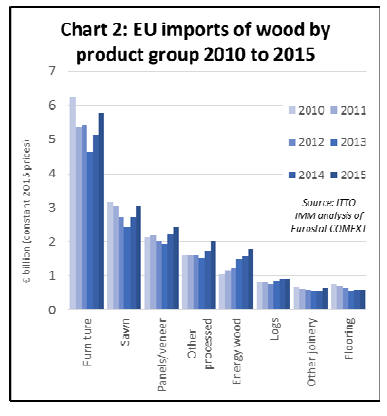
Total imports of wood products from tropical countries
increased 15% from euro3.28 billion in 2014 to euro3.78
billion in 2015. This followed a 6% increase between 2013
and 2014. In terms of share of overall EU imports, 2015
was notable for registering the first reversal in the fortunes
of tropical countries in the last decade.
The share of tropical countries in total EU wood product
import value fell continuously from 35% in 2004 to a low
of 21.4% in 2014, before rebounding slightly to 22.0% in
2015.
Tropical countries lost share initially to China in the
period 2009 to 2010, and then to North American, Russian
and non-EU European countries in the period 2011 to
2014.
However in 2015, tropical countries regained a little share
in import value mainly at the expense of Russia and non-
EU European countries. China*s share in EU imports
remained stable at 32.7% in both 2014 and 2015 (Chart 3).
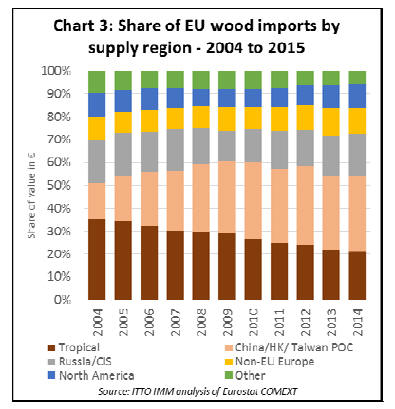
The recovery in EU imports of tropical wood products in
2014 and 2015 was particularly pronounced for furniture
and sawn wood, although there were more minor gains for
all other product groups (Chart 4).
EU imports of wood furniture from tropical countries
increased 11% to euro1.33 billion in 2014 and by a further
16% to euro1.55 billion in 2015.
Imports of sawn wood from tropical countries increased
7% to euro0.87 billion in 2014 and by a further 16% to
euro1.02 billion in 2015. Imports of plywood and veneer
from tropical countries increased more slowly, by 1.4% to
371 million in 2014 and by 6% to euro394 million in
2015.
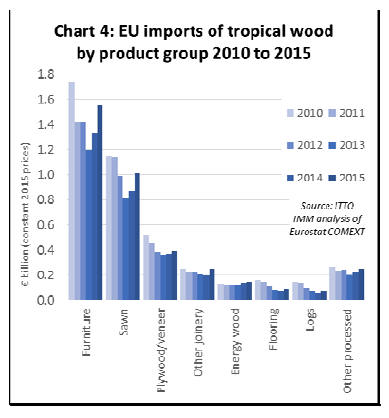
The long-term shift in EU tropical wood imports away
from primary and secondary wood products in favour of
tertiary products continued in 2014 and 2015. The value of
tertiary processed tropical wood products imported by the
EU increased from 55% of total import value in 2013 to
57% in 2015.
Rising EU trade surplus in wood products
The relative weakness of EU currencies, combined with a
strong focus on reducing costs and improving efficiency in
the European wood sector and the slow growth of
domestic consumption, contributed to a sharp rise in EU
exports of wood products to non-EU countries between
2009 and 2015 (Chart 5).
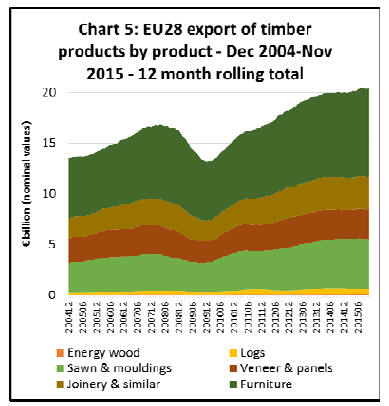
In 2015, the value of EU exports of wood products were
running at their highest ever level at over euro20 billion.
In 2015, the EU had a euro3 billion trade surplus in wood
products which compares to a euro3 billion deficit before
the financial crises. EU export growth has been
concentrated in sawn wood, joinery (notably flooring and
glulam products) and wood furniture.
Although around 30% of EU wood product exports
consistently go to neighbouring European countries
(mainly Switzerland and Norway), since the global
financial crises there has been a significant in rise in
exports to Africa, the Middle East and China alongside
traditional markets in North America and the CIS.
For wood exporters selling into the EU, the weakness of
the euro and sharp rise in the EU*s wood trade surplus
imply intense competition from domestically harvested
timber and manufactured wood products. Due to the wide
diversity of wood manufacturing activities in the EU, this
is true of nearly all wood sectors.
Even in those wood sectors where European
manufacturers have traditionally been weak and more
dependent on imports, such as in supply of durable goods
for outdoor use and in appearance grade wood, new
innovative products are taking share from external
suppliers.
Key innovations include a wide range of new surface
finishes to enhance the appearance and performance of
panel products, and thermal and chemical modification
processes to enhance the durability of domestic wood
species.
At the same time, with traditional markets growing only
slowly, EU wood manufacturers are developing new
products designed to extend the range of wood into new
sectors traditionally dominated by other materials, notably
steel and concrete.
For example, EU production of cross-laminated timber 每 a
product which can successfully compete with steel and
concrete in high-density urban construction 每 increased
from 100,000 m3 in 2005 to 700,000 m3 in 2015.
Legality verification and certification in EU wood
supply
Just how much of the wood traded internationally derives
from legal and sustainable sources is a question frequently
asked by both timber buyers and policy-makers in the EU.
The question has become particularly relevant now that
the EU Timber Regulation obliges all importers to
demonstrate that there is a negligible risk of any illegal
wood entering their supply chains. Unfortunately there is
not a simple answer to this question.
One issue is how to define terms like "negligible risk§ and
※sustainably" sourced. There are large areas of forest
around the world where there is very little risk of illegal
harvest and that would be considered "sustainable" against
most measures, but are not independently verified or
certified. This is particularly true of forests owned and
managed by communities or private non-industrial forest
owners.
Another issue is that certification systems do not measure
the volume of trade in certified products. Typically they
only monitor the area of certified forest and the numbers
of chain of custody certificates issued.
Nevertheless, efforts have being made to overcome these
problems. In 2012, Forest Industries Intelligence (FII) Ltd,
a UK-based company, devised a procedure to estimate
"level of exposure to 3rd party verified/certified wood".
This formed part of a project joint funded by the UK
Department for International Development (DFID), the
EU Timber Trade Action Plan, and European Timber
Trade Federation (ETTF).
That 2012 assessment has now been updated by the ITTO
Independent Market Monitoring (IMM) Project which is
monitoring the market impact of the FLEGT Voluntary
Partnership Agreements (VPAs).
The &level of exposure* is a rough measure to identify gaps
in forest coverage of independent certification and legality
verification systems. It is based on the percentage area of
certified or legally verified commercial forest area in each
individual supplier country.
For example, if 40% of its forest area is known to be
independently certified or legally verified, the level of
exposure of a country*s wood production and exports is
also assumed to be 40%.
The certified/verified forest areas are calculated by
comparing data from the various certification and
verification systems with UN FAO figures for areas of
productive forest land.
&Level of exposure* data can be broken down by
verification system, including FSC, PEFC, or operatorbased
systems of legality verification (such as SGS TLTV,
Smartwood VLO, or OLB). For this assessment, wood
from countries covered by FSC-endorsed National
Controlled Wood Risk Assessment is also considered &3rd
party verified*.
To avoid double counting, areas dual certified to FSC and
PEFC are accounted separately. Adjustments are also
made for a few countries, such as Brazil and the USA,
where there is a big difference in the level of certification
in hardwood and softwood forests.
The new assessment indicates that in 2014, around 80% of
internal EU trade in timber products (including all wood,
wood furniture, pulp and paper) was ※exposed§ to some
form of certification or legality verification. This is simply
due to the fact that a very large proportion of forest area
within the EU is either certified or assessed to be low risk
of illegal harvest in an FSC national controlled wood
assessment (Chart 6).
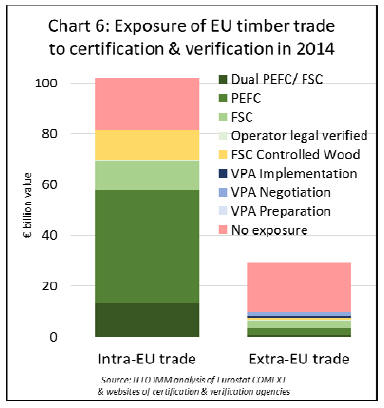
Limited access to certification for wood imported from
outside EU
In contrast to intra-EU trade, level of exposure to some
form of certification or legality verification of all EU
timber products imports from outside the EU was only
around 25% in 2014. While low, this figure is heading in
the right direction, rising from 19% in 2007.
The assessment also indicates that if all timber from the 17
countries that are now engaged in FLEGT VPAs had been
licensed in 2014, the level of exposure to legally verified
timber in EU external trade would have been 8% higher, at
33%.
The increase due to VPA countries excludes areas already
certified or legally verified in these countries (notably by
SVLK in Indonesia, PEFC/MTCS in Malaysia and FSC in
Central Africa) which are already included in the 25%
figure.
Obviously that leaves a large proportion of imports which
are unlikely to be from third party certified or legally
verified sources. Chart 7 shows that China dominates
amongst EU-supplying countries with low exposure to
verified timber. China's level of exposure to certification is
set to increase significantly.
The 2014 data does not include figures for the China
Forest Certification System (CFCS) which was endorsed
by PEFC in February 2014 but had yet to register any
PEFC-certified forest at the end of that year.
By the end of 2015, 5.6 million hectares were registered as
PEFC certified in China and more recent reports from the
China State Forestry Administration indicate that around
10 million hectares of forest are now certified 每 although
most of that area is natural protection forest and China*s
large area of production plantation forest is still largely
uncertified.
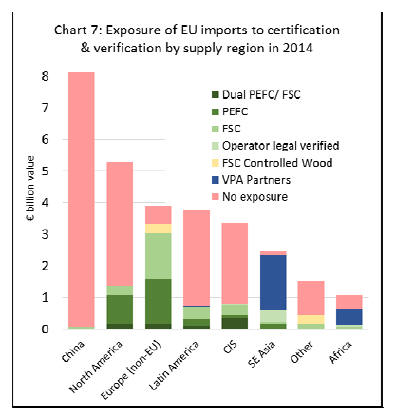
North America is identified as another region with ※low
exposure§ to legality verification and certification. Most
commercial forest land in Canada is certified. In contrast,
the U.S. has a large area of private non-industrial forest
land which is not certified. The US government also has a
long-standing policy commitment not to pursue
certification of federal forest lands.
Latin America is assessed to have relatively low level of
exposure to certification and verification. However this
figure is severely distorted by reliance on forest area to
calculate the index.
The Amazonian rain forest is, of course, huge and only a
tiny proportion is certified. But this area only contributes a
relatively small volume of timber to international trade.
Most of wood product imported into the EU from Brazil
now constitutes softwood or eucalyptus from plantations
outside the tropical zone, many of which are certified.
Therefore the index probably underestimates the real level
of exposure of Latin American wood products in trade.
While the VPA process captures only a relatively small
proportion of total EU imports of timber and timber
products, it is very significant amongst tropical supplying
countries in South East Asia and Africa.
If all timber products imported by the EU from VPA
countries were FLEGT licensed, the level of exposure to
verified timber from Southeast Asia would rise from 25%
to 95% and from Africa from 11% to 60%.
|